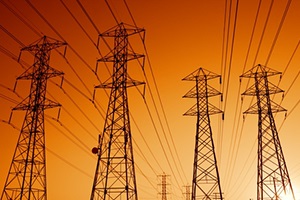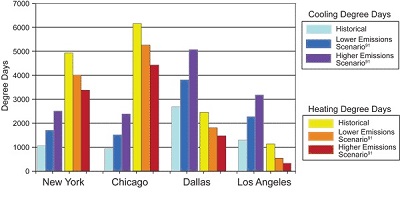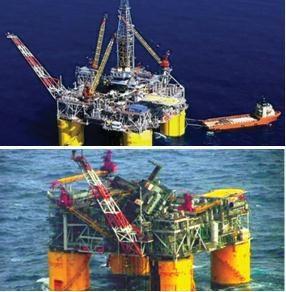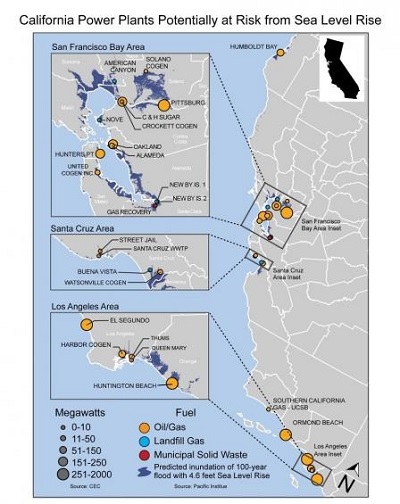|
|
| |
|
|
| |
|
|
|
|
| |
 Climate
Impacts on Energy Climate
Impacts on Energy
Overview
Changes in temperature, precipitation, sea level, and the
frequency and severity of extreme events will affect how
much energy is produced, delivered, and consumed in the
United States.
Energy plays an important role in many aspects of our lives.
For example, we use electricity for lighting and cooling. We
use fuel for transportation, heating, and cooking. Our
energy production and use is interconnected with many other
aspects of modern life, such as water consumption, use of
goods and services, transportation, economic growth, land
use, and population growth. Our production and use of energy
(most of which comes from fossil fuels) also contributes to
climate change, accounting for more than 84% of U.S.
greenhouse gas emissions. |
|
 Temperature,
Energy Demand, and Energy Supply Temperature,
Energy Demand, and Energy Supply
Increases in temperature will likely increase our energy
demand, as well as change our ability to produce electricity
and deliver it reliably.
Picture - Energy
demand is expected to shift by the end of the century. The
number of cooling (or heating) "degree days" refers to the
sum of the number of degrees that each day's average
temperature is hotter (or colder) than 65°F over the course
of a year. As the figure shows, the increase in the number
of cooling degree days is expected to be larger than the
decrease in number of heating degree days, comparing the
historic average and the projected average over the final
two decades of this century. Source: USGCRP (2009)
In a warmer climate, Americans will use more electricity for
air conditioning and less natural gas, oil, and wood for
heating. If the nation's climate warms by 1.8°F, the demand
for energy used for cooling is expected to increase by about
5-20%, while the demand for energy used for heating is
expected to decrease by about 3-15%. Net expenditure in
annual heating and cooling could increase by 10% ($26
billion in 1990 dollars) with a 4.5°F warming by the end of
the century, and by 22% ($57 billion in 1990 dollars) with a
warming of 9.0°F. Heating demand would decrease the most in
the northern United States, and cooling demand would
increase the most in the southern United States. Since
demand for electricity for cooling is expected to increase
as a result of temperature increase and extreme heat events,
the balance in energy delivery is likely to shift from
natural gas and fuel oil used for heating to electricity
used for air conditioning. Changes in energy demand will
likely affect greenhouse gas emissions, but the net effect
depends on which energy sources, including alternative
energy, are used for electricity and heating.
Warming is likely to increase summer peak electricity demand
in most regions of the United States. Meeting increases in
this peak demand could require investments in new energy
generation and distribution infrastructure, and new
mechanisms will need to manage system reliability and peak
demand, which can be more expensive than average demand
levels. For example, based on a 6.3 to 9°F temperature
increase, climate change could increase the need for
additional electric generating capacity by roughly 10-20% by
2050. This would require hundreds of billions of dollars in
additional investment.
A warmer climate may reduce the efficiency of power
production for many existing fossil fuel and nuclear power
plants because these plants use water for cooling. The
colder the water, the more efficient the generator. Thus,
higher air and water temperatures could reduce the
efficiency with which these plants convert fuel into
electricity. |
|
|
 Water
Availability and Energy Water
Availability and Energy
Energy and water systems are connected. Energy is needed to
pump, transport, and treat drinking water and wastewater.
Cooling water is needed to run many of today's power plants.
Hydroelectricity (electricity produced by running water) is
itself an important source of power in parts of the United
States.
Picture - Water and
energy flows. Source: U.S. DOE (PDF)
Changes in precipitation, increased risk of drought, reduced
snowpack, and changes in the timing of snowmelt in spring
will influence our patterns of energy and water use. For
example:
Power plants can require large amounts of water for cooling.
On average, a kilowatt-hour of electricity (enough power to
run 400 typical compact-fluorescent light bulbs for an hour)
requires 25 gallons of water to be withdrawn from rivers or
lakes. Parts of the Southeast and Southwest face increased
competition for water to meet the demands of population and
economic growth while also protecting natural ecosystems.
Many local governments in these regions have slowed or
stopped plans for new power plants that require large
withdrawals of water due to concerns about adequate
availability of cooling water.
More frequent and severe heat waves will likely increase the
demand for electricity in the Southeast and Southwest. At
the same time, these areas are likely to experience reduced
water supplies due to increased temperature and evaporation,
as well as possible decreased rainfall. Since water is
necessary for electricity production, these combined effects
could stress water resources. For more information about
climate change impacts in the Southeast and Southwest,
please visit the Southeast Impacts and Southwest Impacts
pages.
Hydroelectric power plants are sensitive to the volume and
timing of stream flows. In some regions, especially during
times of increased rainfall, dam operators may have to allow
some water to bypass the electric turbines to prevent
downstream flooding. Maintaining stream flow for
hydroelectric dams could present conflicts with other
activities, such as salmon habitat restoration in the
Pacific Northwest.
Growing crops for biomass and biofuel energy could stress
water resources in certain regions, depending on the type of
crop, where it is grown, agricultural production in the
region, and current water and nutrient management practices.
Given the many factors involved, more research is needed to
understand how climate change may affect these resources.
Rising temperatures, increased evaporation, and drought may
increase the need for energy-intensive methods of providing
drinking and irrigation water. For example, desalinization
plants can convert salt water into freshwater, but consume a
lot of energy. Climate change may also require irrigation
water to be pumped over longer distances, particularly in
dry regions across the western United States.
For more information about the impacts of climate change on
water resources, please visit the Water Impacts page. |
|
 Sea
Level Rise, Storm Surge, and Extreme Events Sea
Level Rise, Storm Surge, and Extreme Events
A large portion of U.S. energy infrastructure is located in
coastal areas and therefore sensitive to sea level rise and
storm surge. For example, fuel ports and the generation and
transmission lines that bring electricity to major urban
coastal centers are at risk. Changes in the frequency and
severity of storms and other extreme events may also damage
energy infrastructure, resulting in energy shortages that
harm the economy and disrupt peoples’ daily lives.
Picture - Before and
after photographs of the "Mars" offshore drilling and
production platform, damaged by Hurricane Katrina in the
Gulf of Mexico. Source: CCSP (2008)
A substantial portion of U.S. energy facilities are located
on the Gulf Coast or offshore in the Gulf of Mexico. Several
coastal power plants in the United States are less than
three feet above sea level, and facilities that import or
export coal, gas, and oil are also located in coastal
regions. Sea level rise and more intense storms and
hurricanes in coastal areas could increase the risk of
energy supply disruptions. |
 Several
thousand oil drilling platforms offshore of the Gulf Coast
are vulnerable to extreme weather events. For example,
Hurricanes Katrina and Rita damaged more than 100 platforms
and damaged 558 pipelines in 2005, impacting markets as far
away as New York and New England. Several
thousand oil drilling platforms offshore of the Gulf Coast
are vulnerable to extreme weather events. For example,
Hurricanes Katrina and Rita damaged more than 100 platforms
and damaged 558 pipelines in 2005, impacting markets as far
away as New York and New England.
Picture - Power plants
susceptible to sea level rise in California by type and
size. Source: USGCRP (2014)
Flooding and intense storms can damage power lines and
electricity distribution equipment. These events may also
delay repair and maintenance work. Electricity outages can
have serious impacts on other energy systems as well. For
example, oil and gas pipeline disruptions following extreme
weather events are often caused by power outages rather than
physical damage to the infrastructure.
Railways and marine transportation that move large amounts
of oil and coal in the United States are also vulnerable to
climate change. More intense rainfall and storms can
threaten railways by washing out railway beds. Changes in
precipitation could affect marine transportation by reducing
the navigability of rivers.
For more information about the impacts of climate change on
coastal areas, please visit the Coastal Impacts page. |
|
|
Wind Speed, Cloud Cover, and
Renewable Energy
The impacts of climate change on wind and solar power is
still a developing area of research due to the challenges
involved in modeling wind and cloud cover changes at the
necessary spatial scales. |
|
|
EPA Page |
|
This is the
EPA page for this topic. To see if the Trump
administration has changed the EPA page, simply click the
link and compare the information with this page. If you
notice changes were made to the EPA page, please post a
comment. Thanks. |
|
|
Key Points
Climate change is likely to both increase electricity demand
for cooling in the summer and decrease electricity, natural
gas, heating oil, and wood demand for heating in the winter.
New infrastructure investments may be necessary to meet
increased energy demand, especially peak demand during heat
waves.
Climate change could affect the amount of water available to
produce electricity or extract fuel. In areas where water is
already scarce, competition for water between energy
production and other uses could increase.
Sea level rise and more frequent intense storms could
disrupt energy production and delivery by damaging
electricity infrastructure, fuel delivery infrastructure and
equipment, power plants, or storage facilities.
Renewable Biofuels
The Energy Policy Act of 2005 established the first
Renewable Fuel Standard (RFS), mandating that biofuels be
integrated into transportation fuel to reduce greenhouse gas
emissions.
The Energy Independence Security Act (EISA) of 2007
increased the required amount of renewable fuel to 36
billion gallons per year by 2022.
Annually, the EPA sets volume requirements for each category
of renewable fuel. The volumes are determined by technology
and the availability of each type of renewable fuel.
Every three years, the EPA is required to send a report to
Congress that evaluates the environmental and resource
conservation impacts of increased biofuel production and
use.
For more information about the RFS, visit EPA's RFS page.
For specific information about the environmental assessment,
read the First Triennial Report to Congress. |
|
|
|
|
|
|
|
|
|
|
|
|
Additional Climate Change Information |
Climate Change and Carbon Dioxide
(Beginner - Listening,
reading)
A video lesson to
help with your understanding of climate change
and carbon dioxide.
The English is
spoken at 75% of normal speed.
Great English listening and reading practice. |
Carbon Dioxide and Climate Change
(Beginner - Listening,
reading)
A video lesson to
help with your understanding of carbon dioxide
and climate change.
The English is
spoken at 75% of normal speed.
Great English listening and reading practice. |
Environmental Group Warns Earth's Health at Risk
(Beginner - Listening,
reading)
A video lesson to
help with your understanding of climate change.
The English is
spoken at 75% of normal speed.
Great English listening and reading practice.
A report by the World Wildlife Fund looked at thousands of animal populations
and found they have dropped significantly in 40 years. |
Sea Levels Rising at Fastest Rate in 3,000 years
(Beginner - Listening,
reading)
A video lesson to
help with your understanding of climate change.
The English is
spoken at 75% of normal speed.
Great English listening and reading practice.
A group of scientists say sea levels are rising at record rates. Another group
found that January temperatures in the Arctic reached a record high. |
Capturing CO2 Gas Is Not Easy
(Beginner - Listening,
reading)
A video lesson to
help with your understanding of climate change.
The English is
spoken at 75% of normal speed.
Great English listening and reading practice.
Most scientists agree that carbon-dioxide gas is partly to blame for climate
change: rising global temperatures. But capturing the CO2 gas released by power
stations is costly and difficult. |
Growth, Climate Change Threaten African Plants and
Animals
(Beginner - Listening,
reading)
A video lesson to
help with your understanding of climate change.
The English is
spoken at 75% of normal speed.
Great English listening and reading practice.
Researchers believe Africa may lose as much as 30 percent of its animal and
plant species by the end of this century. |
|
|
|
|
Search Fun Easy English |
|
|
|
|
|
|
|
|
|
|
|
|
|
|
|
About
Contact
Copyright
Resources
Site Map |